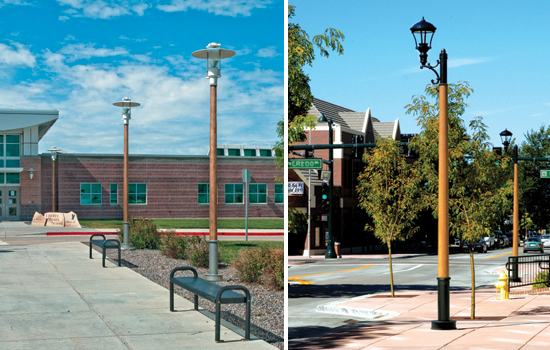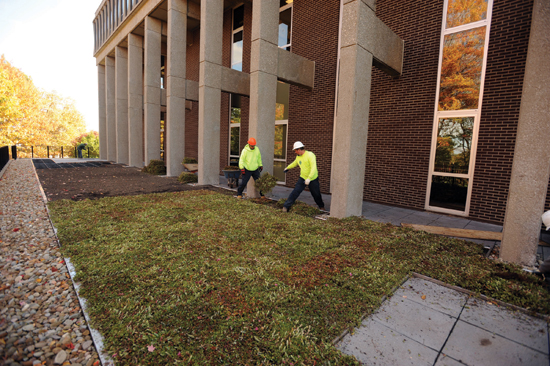Building Green
Enhancing healthy living and green building construction through sustainable and renewable materials
![]() Continuing Education
Continuing Education
Use the following learning objectives to focus your study while reading this month’s Continuing Education article.
Learning Objectives - After reading this article, you will be able to:
- Describe the benefits that may be obtained through the use of materials derived from renewable resources.
- Identify renewable woods that can be used as alternatives to non-renewable South American Hardwoods, which are harvested from rainforests.
- Discuss the benefits of green roof systems.
- Identify the sustainable aspects of using manufactured stone veneers.
Green buildings are sustainable through a multifaceted approach that reduces environmental impacts and enhances healthy living. Green buildings use materials and components that are readily available, environmentally friendly, and that do not burden the environment by draining natural resources. Green buildings are energy efficient and minimize their carbon footprint by using locally available materials as much as possible.
Historically, buildings were constructed from locally and readily available materials. In the Southwest, the Anasazi sited their villages and built their homes into the local rock cliffs and oriented villages so that all of the dwellings received the benefit of naturally available solar heat. Early New England settlers used locally available stone and wood to construct dwellings and barns, and the local stone was used in the construction of the many stone walls that penned farm animals—walls that still crisscross the New England countryside.
The 20th century's green building movement arose out of the need for more energy-efficient buildings and a desire for more environmentally focused construction practices. Oil price increases in the 1970s spurred improvements in energy-efficient design and construction and the use of renewable material resources as well as renewable energy resources.
Green buildings use a number of approaches towards achieving sustainability including:
• Using sustainable and renewable resources and materials in their construction
• Using landscaping to reduce energy consumption and manage stormwater effectively
• Creating healthy living environments by minimizing the use of toxic materials and chemicals
| The U.S. Environmental Protection Agency |
The U.S. Environmental Protection Agency provides basic information on Green Building at their website www.epa.gov/greenbuilding/pubs/about.htm. The EPA website states that: “Green buildings are designed to reduce the overall impact of the built environment on human health and the natural environment by: • Efficiently using energy, water, and other resources, • Protecting occupant health and improving employee productivity, • Reducing waste, pollution and environmental degradation.” |
 |
The green roof at Horizon House Retirement Community Photo courtesy of The Berger Partnership, Landscape Architects |
The incorporation of sustainable materials into project construction requires knowledge of the product's building life-cycle impact (LEED MRc1), environmental impacts (LEED MRc2), raw material sources (LEED MRc3), material ingredients (LEED MRc4), and the manufacturing, fabrication, and shipping processes required to get that material to market. In addition, LEED v4 has changed the evaluation process for Materials and Resources criteria, requiring more rigorous technical standards for qualifying sustainable materials and resources by including:
• The entire life-cycle assessment of the material/resource
• A comprehensive Environmental Products Declaration (EPD) through full disclosure of impacts and ingredients for the material/resource
• Adherence to higher standards such as GreenScreen™, the European REACH (Registration, Evaluation, Authorization, and restriction of Chemicals) program, and others
Sustainable and Renewable Resources and Materials
| Environmental Product Declarations |
Environmental Product Declarations act like food labels. EPDs provide transparency in communication of environmental data about a product to facilitate comparisons between products. EPD information includes the product’s raw material source or acquisition; the energy use and efficiency of the product; the materials content and chemical substances used in the product composition; emissions into the air, soil and water and the waste generated through product harvesting, fabrication and manufacture. |
This article will provide examples of products that qualify as renewable materials/resources by green building and sustainable design criteria. Some of these products are obtained directly from renewable resources (forest products) while others are produced by processes that mimic non-renewable natural resources rather than deplete their supply. One product utilizes living renewable plant resources as part of its function to manage stormwater and provide energy-efficient roofing for buildings. Using any of these products on a project can assist in enhancing the healthy living environment and sustainability of the project.
Renewable Wood
Wood has been used for centuries as a construction material. It is considered a sustainable building material as it is harvested from a renewable source (forest land) and has a “low embodied energy”1 due to the following factors:
• There is minimal non-renewable energy used in the harvesting and production of timber and in its construction use.
• Due to its natural thermal properties, structures built of wood rely less on carbon-emitting appliances for heating and cooling.
• Many wood products (especially hardwoods) have a service life of 50 or more years and require minimal maintenance.
• Wood can be readily recycled, thus providing a low carbon footprint.
Forests play a key role in natural water-carbon-nitrogen cycles. For years, many wood products were treated with chemical preservatives to increase their durability and provide added protection from rot and insects. Most of these chemical preservatives later proved to be toxic to both human health and the environment and their use was discontinued. In an effort to provide wood products with increased durability and longevity, timber companies began to harvest South American and Latin American hardwoods such as Ipe, Cocobolo, Bocote, and Parota. The harvesting of these woods has begun to deplete stands of tropical rainforests. Although many of the South American woods are certified through the Forest Stewardship Council (FSC) and are thus considered responsibly harvested, other woods are harvested illegally or do not meet FSC criteria and certification.
Thermally Modified Hardwoods
Thermally modified North American hardwoods are used as exterior tiles for roof decking, ground-level decking, and as wood components for landscape site furniture such as benches, chairs, and tables. These wood products do not require chemicals to enhance their durability or resistance to decay as the thermal heat process provides this durability. Thus, the product is ecologically and environmentally safe.
 |
Thermally modified wood tiles, built onto adjustable paver pedestals Photo courtesy of Tournesol Siteworks |
These thermally modified North American hardwoods are domestically sourced from red oak and ash trees that are currently harvested in Wisconsin. Red oak and ash are the preferred species because of their consistency in durability and color. The natural durability of the red oak and ash is enhanced through the thermal heating process, creating a product that is a Grade-A wood with a 25-year Class 1 durability level and a resistance to decay that is comparable to South American hardwoods.
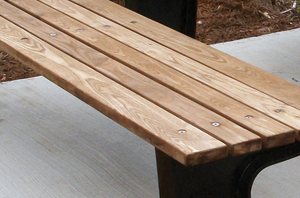 |
Detail of bench made from thermally modified North American hardwood Photo courtesy of Tournesol Siteworks |
The thermal wood process was originally developed in Finland and the U.S. company that provides the thermally modified wood product utilizes special kilns fabricated in Finland. These kilns provide high temperature heat with steam, and the process changes the chemical composition of the wood, making it highly resistant to rot, decay (EN-350-2 Standard), and pests as the resin and sap content are essentially cooked out of the wood. The thermal process also creates a very aesthetically pleasing dark-colored wood product.
The thermally modified hardwood is FSC certified, harvested, processed, and finished. The wood decking products have a Class B fire rating based on ASTM E-84-10 standard test method for surface burning. (Note: the wood decking products must be treated with fire retardant to achieve a Class A fire rating).
Thermally modified North American hardwood products are lighter in weight and easier to cut and work with than many of the South American hardwoods such as Ipe. Red oak and ash are easy to cut and easy to use in construction. In addition, the cell structure of the red oak and ash changes during the thermal modification process, making the wood resistant to warping, twisting, and other moisture-related movements and thus providing long-term dimensional stability.
Thermally modified North American hardwood products have been used for both decking and benches at the Patagonia Clothing Company headquarters in Ventura, California. The company embraced the use of the reclaimed wood as it closely reflects their own corporate ethos. The project designer suggested this product specifically because of the qualities of thermally modified North American hardwood. The Patagonia Clothing Company is pleased with the overall performance of the wood over the first year (the benches were installed winter 2013), and the company is planning to add additional benches to the project site.
Thermally modified North American hardwood products are a sustainable and renewable resource in that they are sourced and harvested in the U.S. from forest crops that can be replanted and they are 50 percent lighter than South American hardwoods so there is less energy (as well as less cost) used in processing and shipping. They also meet LEED MR Criteria through FSC certification and lack of toxic chemical content.
Laminated Wood Poles
Laminated wood poles are a product that can add aesthetic value as well as sustainability to a project. Laminated wood poles utilize the renewable resource of wood in their composition and hence meet a number of LEED MR criteria both by using a renewable resource and by using less energy than metal or synthetic composites in their manufacture.
Dead Alaskan Yellow Cedar trees or “snags” are used in the fabrication of laminated wood poles. The Alaskan Yellow Cedar tree is a slow growing species that produces a dense growth ring structure, resulting in natural decay resistance to disease and insects, thus requiring no chemical preservatives or treatments. Testing completed by the USDA Forest Service (USDA-FS) in the 1990s on dead “snags” showed that “all wood tested from the dead yellow-cedar trees, regardless of the number of years the trees had been dead, appeared to maintain strength with time. Not one of the snags, in any class, had lost enough strength to prevent it from potentially being used.”2 Many of the harvested Alaskan Yellow Cedar trees have been dead for up to 80 years. The trees were tested for both hardness and bending strength in these USDA-FS tests and the dead trees were found to be as strong as a living tree.
The laminated wood also gains increased strength as a result of the lamination process, making it as durable in exterior conditions as steel or aluminum. Product testing results have shown these laminated wood poles to be stronger than fiberglass and aluminum poles.
The shafts of the laminated wood poles are made of laminated beams that are fabricated from locally sourced materials and components. The tapered shaft comes in lengths up to 25 feet and has an internal wire way. On-site installation is facilitated through a gasketed internal wiring compartment inside a cast aluminum base. The poles can accept any style lighting luminaire fixture or arm via an aluminum tenon assembly bonded at the top of the pole shaft.
In using dead trees from a forest resource, laminated wood poles meet criteria for both a renewable resource and a recycled resource (dead trees); additionally, wood is a carbon absorber rather than a carbon producer. The fabrication process for these laminated wood poles uses less energy than that required for steel, fiberglass, or other metal poles. The laminated wood poles are manufactured in the U.S. of locally sourced materials as all components, except for the trees, are produced within 50 miles of the production facility to minimize the energy consumed during the manufacturing cycle.
Laminated wood poles are typically used where site lighting is an integral part of the landscape design for a project and complementary to the building exterior. While standard metal poles may be used in a parking lot, wood poles are typically used for pedestrian scale lighting, particularly as you approach the entrances and pathways to a building. Laminated wood poles have been used in downtown renewal projects, streetscapes, schools, and retail locations.
Laminated wood poles were an integral component in a concept design for a connector between the Delaware River and Penn Treaty Park in Philadelphia, Pennsylvania. Penn Treaty Park is the site where William Penn signed a treaty with the Lenape tribe. This project is part of a Penn DOT improvement that involves better lighting, access, and streetscaping, as well as the construction of another smaller park. Artist Donald Lipski's design used laminated wood light poles to guide a pedestrian walk to the river. Two light poles will flank the entranceway to the underpass—one with a fiberglass wolf sculpture on top and another with a fiberglass turkey on top. At the other end of the underpass, a series of light poles will lead into the park; in this case each one will stand on the back of a cast bronze turtle. The Lenape origin myths include animals that are associated with its three clans: wolf, turkey, and turtle.
Environmentally responsible alternatives to South American woods include two new products. Both thermally modified North American hardwoods and laminated wood poles fabricated from responsibly harvested Alaskan Yellow Cedar trees meet the criteria for renewable resources and responsible forestry. In addition, thermally modified North American hardwoods are FSC certified.
|
Green Roof Technology
The modern green roof movement began in Germany in the 1980s. These first green roofs used materials that were repurposed from other applications. For example, air barriers or felt from the building envelope were repurposed as water retention layers, and landscape nursery trays were repurposed as green roof plant trays. The use of repurposed materials presented problems, fostering further research to develop technology solely for green roofs.
These new products and systems focus on green roof technologies for stormwater management and fall into two categories of green roof assemblies, manufactured and installed in conjunction with roofing membrane partners. In some cases, a major advantage lies in having a single-source warranty for all components of the green roof.
The two major categories of green roof assemblies are 1) multi-layer or built up and 2) tray-based. The multi-layer green roof assembly is the most flexible in depth and layout. This assembly presents the opportunity for construction of an intensive roof garden due to the potential for greater depth of planting and the ability to easily accommodate organic shapes. Multilayer assemblies can also accommodate the very shallow growing media sometimes used in retrofit applications.
The tray-based green roof assemblies have a more restricted range of planting depths but they are the easiest to install and provide easy access to maintain the roof membrane underneath. The trays are, however, interlocking and once all of the trays are locked together, the medium can be surcharged and the depth can be increased by adding 3 to 4 inches of soil on top of the trays. The most common plants used in extensive green roofs are sedums, which are extremely hardy and come in a wide variety of different mixtures for specific regions and aesthetic goals. The tray systems are designed for the best stormwater management properties. They meet multiple LEED MR criteria as they have components that are manufactured from 88 percent recycled content. The tray assemblies also have internal drip irrigation built into the trays.
The structural requirement for green roofs is dependent on the size of the roof, the size and depth of the soil, and the growing medium. The design of larger roof gardens for the assembly can be very involved, especially when stormwater management calculations are required, but the green roof technology team will provide an accurate weight calculation based on the green roof's required size, depth, and water retention.
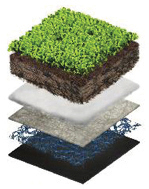 |
Detail showing a green roof multi-layer assembly Image courtesy of Columbia Green Technologies |
Green roof technologies must meet FLL guidelines, which are standards that were developed in Germany for growing media and which have been accepted in the U.S. These standards govern the growing medium and evaluate its air porosity and maximum saturated weight. Other standards which must be met are Factory Mutual Assurance (FM) certifications.3 In addition, green roof technologies for stormwater management must meet the latest LEED v4 Materials and Resources criteria for Environmental Product Declarations by providing a listing of all ingredients used in the assemblies and membrane for the system. The Declare label ensures that all components are “red list free” meaning that it is free of toxins and it meets the standards for certification through the Living Building Challenge.4
With respect to specifying this product for a project, it is recommended that Master Format Section 07 55 63 Vegetated Protected Membrane Roofing of the Construction Specifications Institute (CSI) be used to provide better coordination between the architect and the landscape architect on the project.
Green roof technologies for stormwater management have been implemented at a number of locations throughout the U.S. and Canada including Kent State University's Taylor Hall in Kent State, Ohio, and Horizon House Retirement Community in Seattle, Washington.
Beth Ruffing, assistant director in the Office of the University Architect and project manager for the roof garden on Kent State University's Taylor Hall, says, “green roofs can have many environmental benefits; they reduce cooling costs for buildings and they slow the speed of stormwater to release stress on drainage systems. In addition, they're visually appealing and provide an opportunity for our students to learn about sustainability.” She continues, “this green roof will require very little maintenance. The sedum plants are watered by an integrated irrigation system and do not require mowing or chemical weed control.”
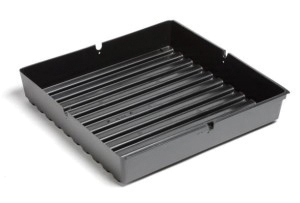 |
Detail showing an empty tray for the green roof tray assembly Photo courtesy of Columbia Green Technologies |
Meanwhile, at the Horizon House, “a dynamic retirement community dedicated to dignified aging,” the green roof is “an integral part of providing a healthy, green, and sustainable residential environment,” says Brad D'Emidio, director of Building Services and the Horizon House Retirement Community.
Green roof technologies for stormwater management reflect an upward trend in green roof technology that meets all of the private, public, and design-based benefits and also addresses tax-credit incentives that are now being introduced in various communities such as in Washington, D.C., where planning policy provides credits for plans that utilize green roofs to help to manage stormwater.
The city of Seattle, Washington has an innovative development standard called the Seattle Green Factor (SGF), which is a scoring system designed to promote ecologically functional as well as attractive urban landscaping and which provides incentives for the use of green roofs as well as other green building technologies.5
The benefits of green roof technology are wide ranging. They include management of stormwater, reduction of heat island effects, restoration of habitat, biodiversity of plant and wildlife, water efficiency, energy optimization through both cooling and heating, reuse of building materials, recycled-content materials, increased roof durability and longevity, and creation of rooftop amenity spaces. |
|
The organization Green Roofs for Healthy Cities (www.greenroofs.org) cites a number of public, private, and design-based benefits from green roofs including: Public Benefits
Private Benefits
Design-Based Benefits
|
Using Manufactured Stone Veneers to Mitigate Environmental Impacts
Natural stone is a durable, attractive product that must be quarried and processed to make it usable as a veneer or architectural siding. Manufactured architectural stone veneers are also durable, attractive, and manufactured for use as both interior and exterior veneers and siding. They are one-third the weight and one-half the installation cost of natural stone. They are also sustainable and place minimal impact on the natural environment because they are not quarried but are cast from molds.
The manufacturing process involves having the fabricators visit quarries to select pieces of natural stone that have already been quarried. Molds are then cast from these natural stone pieces. The molds are filled with Portland cement, lightweight aggregate, and iron oxide dyes so that the veneer pieces are fabricated in the appropriate size and color. The natural stone textures are achieved because the molds are created from natural quarried stone pieces. Some manufactured stone veneer products come with an extended warranty. Manufactured stone veneers are easily maintained and damaged pieces can be replaced by re-casting the molds.
Manufactured stone veneers are fabricated in large multi-panel systems, which facilitate installations covering extremely large areas and allow a much larger surface area to be covered in less time than in a natural stone application. The variation of natural stone is achieved by replicating limited areas of natural stone mold per profile so that there is less chance of repetition.
|
As manufactured stone veneers are not quarried, there is only a 2 percent waste in their fabrication versus a 10 percent waste with natural stone. The lighter weight of the veneer reduces both the energy use and cost involved with shipping and all of the manufactured stone veneers can be recycled and reused. Additionally, their light weight eliminates the need for wall ties, and thus they are designed to adhere easily to a variety of structurally sound surfaces, and are capable of being used in installations that would normally be very difficult and costly to achieve with natural stone.
Manufactured stone veneers are tested for freeze/thaw durability. As with any installation, installers should incorporate good building practices which include proper flashing and water diversion techniques to help ensure a successful installation. The base color in manufactured stone veneers is blended throughout and permanent mineral oxide pigments are applied and absorbed when the veneer is cast. The color is an integral part of the veneer and there are minimal noticeable color changes after years of weathering.
 |
An example of a manufactured stone veneer pattern that mimics natural stone Photo courtesy of Eldorado Stone |
Manufactured stone veneer is easy to maintain by simply cleaning dirt or other particles with a soft bristle brush. If necessary a mild type of detergent mixed with water can be used to clean the surface of the stone. Rinse right away with clean water to remove any cleaning solution that might remain on the surface. Never use wire brushes, acid cleaners, power washers, bleach, paint remover, or any other type of concrete cleaner. If efflorescence occurs, it may be removed with a solution of 1 part mild detergent to 6 parts water. Scrub using a soft bristle brush. Rinse well with clean water. It is not necessary to seal manufactured stone veneers but if a sealant is applied, it will provide added protection and make it easier to clean. There are urethane and wax-based sealers that can damage the surface or cause it to “yellow.” Other sealers may encourage additional efflorescence on the stone's surface.
The manufactured stone veneer is essentially a concrete product meeting the following composition and standards:
• Cement meeting the requirements of ASTM C150, C595, or C989
• Pozzolans meeting the requirements of ASTM C618
• Aggregates meeting the requirements of ASTM C33, C330, or C331
• Admixtures
• Coloring pigments
• Potable water
Manufactured stone veneers have been used both on the exterior and interior of buildings for walls, chimneys, and accents on residential, commercial, and municipal projects. These products come with long-term warranties. However, manufactured stone veneers cannot be used in pools, fountains, showers or water features nor can they be used as a horizontal surface such as patios or floors. Some examples of projects using manufactured stone veneers include a cabin near Lake Superior in northwestern Wisconsin, designed by architect Tom Jones of TRJ Design in Trabuco Canyon, California. Mr. Jones stated:
“I wanted to create a home where they could live year round if they chose with a clean, open floor plan and a simple design that always keeps nature at the forefront. My parents are fans of modern architecture, but not the sterile style. To add warmth and natural beauty to the plans, we used three key design elements—wood, glass, and manufactured stone veneer.”
Manufactured stone veneer was also used to complement other organic building materials at Parkland Golf and Country Club in Florida. Throughout the community, stone, wood, water, and other organic materials were used as the primary elements to define the context of the landscape and residences. Manufactured stone veneer is used on both the exterior and interior of the sports club, on bridges, community signage, and on various homes throughout this community.
“The level of detail and thoughtfulness found in every aspect of this community is highly unique and very special,” says Margaret LaCalle, project manager for WCI Communities, the developers of the Parkland golf community. “The feeling here is magical and I believe the architectural beauty and the ambience created with the use of the manufactured stone veneer helps to capture the true essence of Parkland Golf and Country Club.”
Conclusion
As we look to reduce our carbon footprint and move towards more net-zero projects, demand will increase for the construction of buildings that minimize impacts to the environment and provide opportunities for energy savings both in their construction and maintenance. There will also be a continued demand for products which are either harvested from renewable resources or fabricated using materials that are not toxic and which do not drain non-renewable natural resources.
| ENDNOTES | |
| 1 | www.forestlearning.edu.au |
| 2 | U.S. Department of Agriculture Forest Service, Forest Product Laboratory: Research Paper FPL-Rp-565, Mechanical Properties of Salvaged Dead Yellow Cedar in Alaska: Phase 1, K. McDonald, P. Hennon, J. Stevens, D. Green. |
| 3 | A typical FM Approvals program for roofing includes fire testing above and below the deck, wind-uplift testing, hail-damageability testing, accelerated weathering testing, and corrosion resistance testing of ferrous metal parts. |
| 4 | http://living-future.org/lbc |
| 5 | Refer to https://www.seattle.gov/DPD/cityplanning/completeprojectslist/greenfactor/ for more detailed information. Portland, Oregon also uses an incentive calculation that evaluates the return on investment in green design components. |
 |
 |
 |
 |

